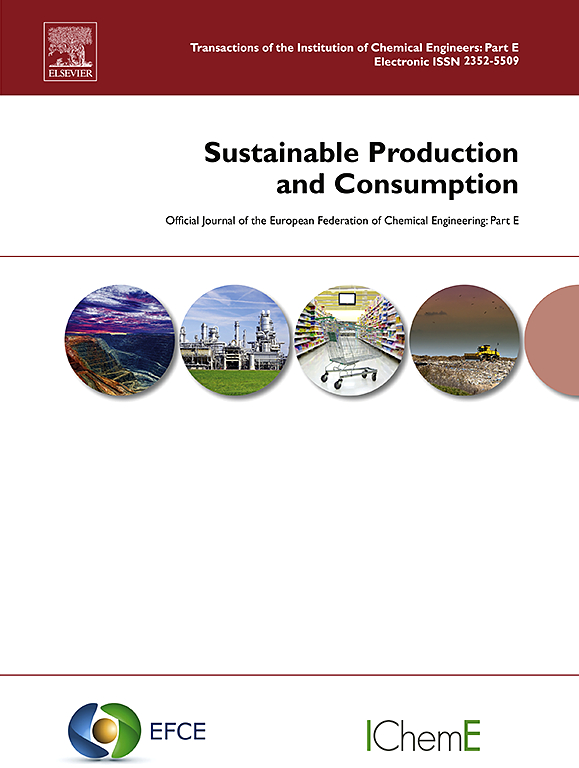Driving sustainability at early-stage innovation in production of zinc oxide nanoparticles
IF 9.6
1区 环境科学与生态学
Q1 ENVIRONMENTAL STUDIES
引用次数: 0
Abstract
Despite its industrial relevance and the methods that have been described for its synthesis, little is known about the performance of the production processes of ZnO nanoparticles (ZnO NPs), either pure or doped, from the sustainability perspective. The Safe-and-Sustainable-by-Design (SSbD) framework brings to this context an excellent opportunity to 1) evaluate the impacts of chemical processes from the safety and sustainability perspectives, and 2) design and test safety and sustainability strategies to study and optimise these key aspects in early innovation stages. This work aims at assessing the production of ZnO NPs using this approach, testing the sustainability of the materials, designed and produced by Phornano, an Austrian SME, under this scheme. Three scenarios were analysed: the original process (BS) and two alternatives resulting from the application of SSbD strategies to the former (S1 and S2). BS is a linear process in which Zn(NO3)2·6H2O, whey, water and a dopant (a Mn salt) are used as starting materials. However, obtention of the desired product entails the release of toxic fumes (SOx and NOx) to the atmosphere. S1 and its scale-up version, S2, are circular processes in which SOx emissions are avoided, due to the replacement of whey by a non-aminated starch, and NOx are transformed into HNO3, which reacts with Zn powder to produce Zn(NO3)2·6H2O; in this way, no harmful substances are freed and the zinc salt employed as a raw material in BS is generated during the manufacture of ZnO NPs. Four well-known evaluation tools were employed to achieve a holistic sustainability perspective: Environmental Life Cycle Assessment (LCA), Material Flow Cost Accounting (MFCA), Social Life Cycle Assessment (S-LCA) and Multi-Criteria Decision Analysis (MCDA), according to the standardised methodologies or the most broadly spread ones; the study was complemented with an uncertainty analysis. The results for the production of 1 kg of ZnO NPs show that the after-SSbD scenarios are remarkably more sustainable than BS: the environmental evaluation reveals that S2 outperforms BS for 10 environmental indicators, allowing a reduction of 67 % in terms of total aggregated impact (from 13.7 to 4.4 mPt); from the economic viewpoint, synthesis of ZnO NPs through S2 is around four times cheaper than that achieved via BS (512 vs 2206 €); finally, the social footprint is reduced from 159 mPt in the original process to 21 mPt in S2. MCDA of BS, S1 and S2 considering the three assessments performed confirms that S2 is, with almost 100 % probability, the best-performing alternative from the sustainability perspective, followed by S1. Overall, this work, the most complete in this field to date, contributes to the sustainable synthesis of ZnO NPs and to the methodological advance of the SSbD framework through the revision of its limitations and opportunities.

在氧化锌纳米颗粒生产的早期创新中推动可持续发展
尽管其工业相关性和合成方法已被描述,但从可持续性的角度来看,对ZnO纳米颗粒(ZnO NPs)的生产过程的性能知之甚少,无论是纯的还是掺杂的。安全与可持续设计(SSbD)框架为这一背景带来了一个极好的机会:1)从安全和可持续性的角度评估化学过程的影响;2)设计和测试安全和可持续性战略,以在早期创新阶段研究和优化这些关键方面。这项工作旨在评估使用这种方法生产ZnO纳米粒子,测试材料的可持续性,由奥地利中小企业Phornano在该计划下设计和生产。分析了三种情景:原始过程(BS)和应用SSbD策略对前者产生的两种替代方案(S1和S2)。BS工艺是以Zn(NO3)2·6H2O、乳清、水和掺杂剂(Mn盐)为起始原料的线性工艺。然而,对所需产品的关注需要将有毒烟雾(SOx和NOx)释放到大气中。S1及其放大版S2是循环过程,其中由于乳清被非胺化淀粉取代,避免了SOx的排放,NOx转化为HNO3, HNO3与锌粉反应生成Zn(NO3)2·6H2O;这样,在制备ZnO纳米粒子的过程中,不会释放出有害物质,并且产生了作为BS原料的锌盐。采用了四种著名的评估工具:环境生命周期评估(LCA)、物料流成本会计(MFCA)、社会生命周期评估(S-LCA)和多准则决策分析(MCDA),根据标准化的方法或最广泛传播的方法;这项研究还附有不确定性分析。生产1 kg ZnO NPs的结果表明,ssbd后情景比BS更具可持续性:环境评估显示,S2在10个环境指标上优于BS,总总影响减少了67%(从13.7 mPt降至4.4 mPt);从经济角度来看,通过S2合成ZnO NPs的成本是通过BS合成ZnO NPs的四倍左右(512欧元对2206欧元);最后,社会足迹从原始流程中的159 mPt减少到S2中的21 mPt。考虑到所进行的三项评估,BS、S1和S2的MCDA证实,从可持续性的角度来看,S2几乎有100%的可能性是表现最佳的替代方案,其次是S1。总的来说,这项工作是迄今为止该领域最完整的工作,通过修正其局限性和机会,有助于ZnO NPs的可持续合成和SSbD框架的方法进步。
本文章由计算机程序翻译,如有差异,请以英文原文为准。
求助全文
约1分钟内获得全文
求助全文
来源期刊

Sustainable Production and Consumption
Environmental Science-Environmental Engineering
CiteScore
17.40
自引率
7.40%
发文量
389
审稿时长
13 days
期刊介绍:
Sustainable production and consumption refers to the production and utilization of goods and services in a way that benefits society, is economically viable, and has minimal environmental impact throughout its entire lifespan. Our journal is dedicated to publishing top-notch interdisciplinary research and practical studies in this emerging field. We take a distinctive approach by examining the interplay between technology, consumption patterns, and policy to identify sustainable solutions for both production and consumption systems.
 求助内容:
求助内容: 应助结果提醒方式:
应助结果提醒方式:


